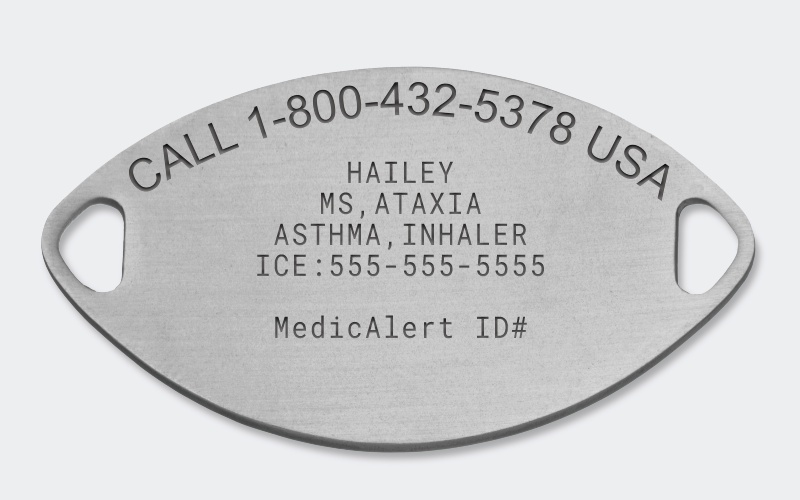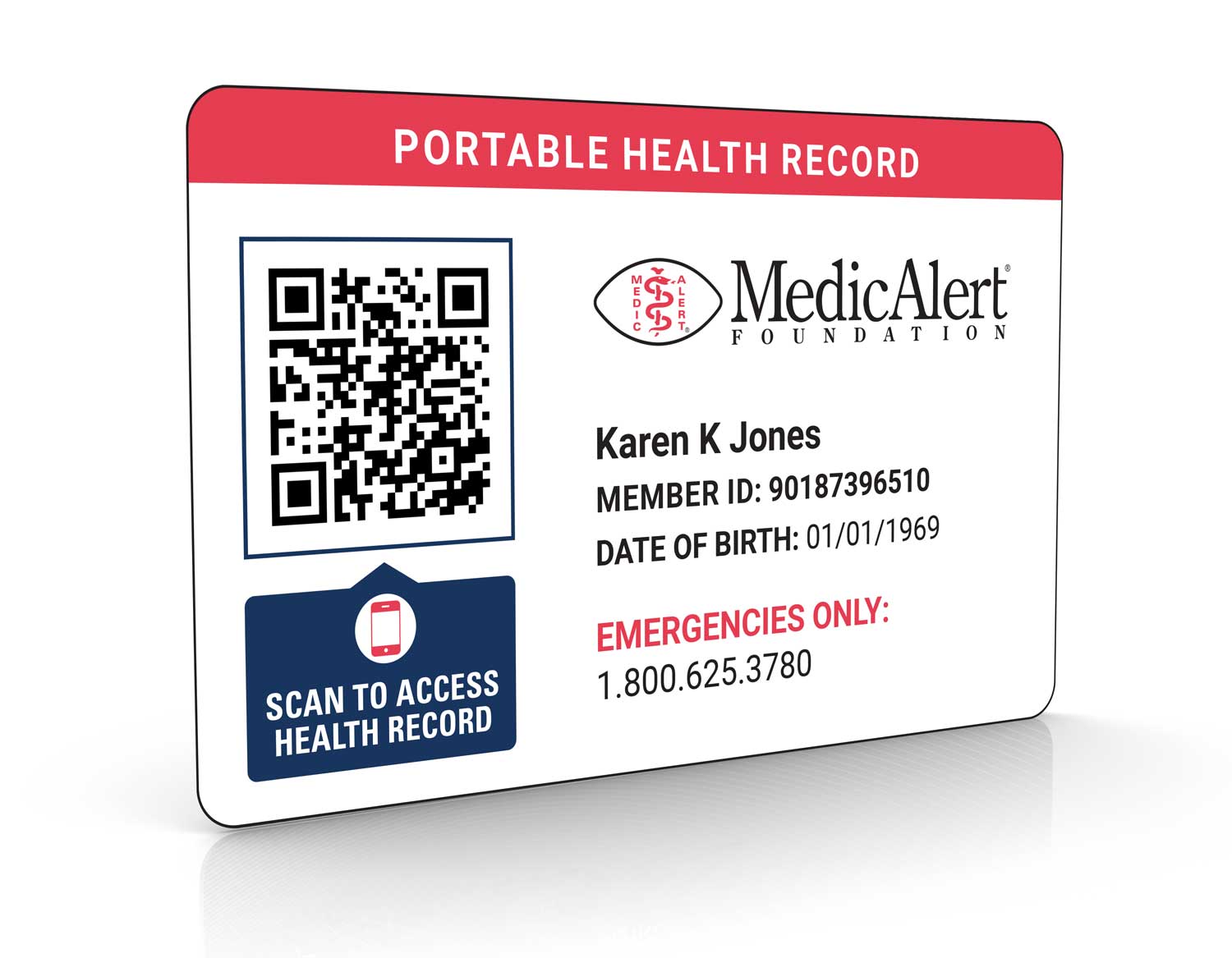Help others help you. Wear a medical alert ID bracelet or necklace engraved with important information for emergency responders and healthcare providers
Centers for Disease Control & Prevention

Medical IDs for Ataxia
The confidence to live with ataxia
Ataxia is a rare condition that affects a person’s coordination. The disorder can be present at birth or it can develop at any age and for many different reasons. Ataxia is unpredictable, so it can be temporary, curable, or long-term, with symptoms that can come and go.
For some people living with ataxia, the condition can have a minor effect on day-to-day living. In others, it can cause extreme disruptions in life, making the condition stressful and even dangerous.
This is why people living with this condition should wear a MedicAlert medical ID for ataxia.
How MedicAlert protects those living with ataxia
One thing you shouldn’t worry about is what could happen if there’s an emergency. MedicAlert’s protection plans offer benefits that extend beyond the ID, providing safety and peace of mind for people living with ataxia, their families and caregivers.

24/7 Emergency Response
Our team provides first responders the information they need to provide fast, accurate care.

Digital Health Profile
All your vital information, all in one place for you and your caregiver.

Emergency Contact Notification
In an emergency, we connect families so that no one is alone in a crisis.

Patient Instructions
Share the information that’s important to your care, such as use of rescue medications or contraindication for tests like MRIs.
Pair a medical ID for ataxia with the protection plan that’s right for you.
What is ataxia?
Ataxia is a condition that causes loss of muscle control in the arms or legs. This leads to lack of coordination and balance, and difficulty walking. Ataxia can also affect the fingers, hands, speech, swallowing, and eye movement. People living with ataxia can have slurred speech and they can stumble and fall. Because ataxia affects the way a person moves and communicates, people with the condition are often mistaken for being intoxicated. This is why people with ataxia should wear a MedicAlert ID.
If you are experiencing a medical emergency, an inaccurate assessment of your condition could cause delays in treatment and it could even result in receiving the wrong treatment. A MedicAlert ID can let emergency responders and ER doctors know that you are living with ataxia, ensuring that you will receive the fastest, safest, and most appropriate treatment.
Types of ataxia
Ataxia is a rare condition that affects around 150,000 people in the U.S. today, and many different types exist. Some are hereditary, others are acquired. In rare cases, ataxia can be degenerative, meaning it can be caused by traumatic injury, aging, or wear and tear. Although rare, the most common type of hereditary ataxia is Friedreich’s ataxia.
Affecting an estimated 1 in every 50,000 people, Friedreich’s ataxia typically develops before the age of 25. In addition to balance and coordination problems, people living with Friedreich’s ataxia may have scoliosis (abnormal curvature of the spine), vision or hearing loss, diabetes, thickening of the heart muscles, chest pain, breathlessness, and loss of feeling in the hands and feet (peripheral neuropathy).
Other types of hereditary ataxia include:
Ataxia-telangiectasia (AT)
Symptoms begin in early childhood and most children will need a wheelchair by 10 years of age. The condition is characterized by common ataxia symptoms plus a weakened immune system, very slow eye movements, and clusters of blood vessels in the corner of the eyes or on the cheeks.
Episodic ataxia
Characterized by alternating episodes of ataxia and mild to no symptoms at all. Episodes may last from just a few minutes to hours. This rare and unusual type of ataxia can also cause vertigo, tinnitus, and migraines, and it is usually triggered by alcohol, stress, exercise, caffeine, or sudden movement.
Spinocerebellar ataxia (SCA)
A group of hereditary ataxias that typically begin in adulthood (ages 25 to 80). In addition to coordination problems, people living with SCA may have memory loss, muscle stiffness and cramps, bladder problems such as urinary urgency or incontinence, and peripheral neuropathy. Many people living with SCA may have to use a wheelchair.
What causes ataxia?
Ataxia can have hereditary, acquired, and degenerative causes. Researchers at Mayo Clinic have found that people living with hereditary ataxia may have been born with a mutation in a certain gene that makes irregular proteins. These abnormal proteins impede the function of nerve cells, primarily in the cerebellum (the part of the brain in the back of the head that controls balance and other complex motor functions) and spinal cord. This causes nerve cell degeneration. As the condition progresses, coordination problems worsen.
Ataxia can also be caused by inner ear problems. The inner ears are part of your sense of balance. When this balance is disrupted, it can become difficult to coordinate how you move.
Acquired causes of ataxia include:
- Autoimmune diseases such as sarcoidosis and celiac disease
- Brain abscesses
- Cancerous (malignant) or noncancerous (benign) tumors
- Cerebral palsy
- Excessive alcohol use
- Excess vitamin B-6
- Head trauma, brain hemorrhage
- Hypothyroidism or hypoparathyroidism
- Infections such as chickenpox in childhood, HIV, and Lyme disease
- Medications and drugs, especially barbiturates and antiepileptic drugs
- Multiple sclerosis (MS)
- Severe COVID-19 infection
- Some types of chemotherapy
- Stroke
- Toxins from lead, mercury, and solvents
- Vitamin E, B-1, B-6, B-12, and thiamine deficiencies
Some acquired causes of ataxia, such as head trauma, brain hemorrhage, stroke, drugs, and infection can cause the condition to appear suddenly. Other acquired causes such as alcohol abuse, chronic exposure to certain drugs, vitamin deficiencies, MS, and hypothyroidism, can cause ataxia to appear gradually.
Multiple system atrophy (MSA) is a degenerative cause of ataxia and it affects adults beginning at around age 50. In addition to common symptoms for ataxia, other problems associated with MSA include low blood pressure, bladder incontinence, and REM sleep disorders (punching, kicking, and yelling while sleeping).
Paraneoplastic syndromes are other degenerative causes of ataxia. These rare disorders are triggered by the immune system response to cancerous tumors commonly associated with lymphoma or breast, lung, or ovarian cancer.
What are the symptoms and complications of ataxia?
People living with ataxia will experience a number of common symptoms, as well as other symptoms specific to the type of ataxia. For example, people with episodic ataxia may experience migraines, individuals with AT may have a weakened immune system, and people living with SCA ataxia may have bladder dysfunction such as urinary urgency or incontinence.
The most common symptoms of ataxia include:
- Balance and coordination problems (usually the first symptom to appear)
- Difficulty with writing and eating
- Poor coordination of hands, arms, and legs
- Slow eye movements
- Slurring of speech
- Trouble swallowing
- Wide-based gait (manner of walking)
Depending on what caused the ataxia, some people may have other symptoms such as depression, dementia, or behavioral problems.
Complications of ataxia are as varied as its types. A person living with ataxia may have untreatable symptoms such as severe rigidity (stiffness or inflexibility), they may fall often, which can lead to injuries, or they may need to use a wheelchair or become immobile (bed bound), which can lead to blood clots, infections, and bedsores. In other cases, a person living with ataxia may have trouble breathing or they might choke, which can lead to death.
Other complications associated with the different types of ataxia include:
- Bowel dysfunction
- Dizziness
- Fatigue
- Pain
- Sexual dysfunction
- Tremors (shaking)
The symptoms and complications of ataxia can be extreme, unpredictable, and even dangerous.
This can create numerous safety issues in an emergency situation. Medical IDs for ataxia can help by letting emergency responders know that you are living with ataxia. With a MedicAlert ID and protection plan, emergency responders, ER doctors, and other emergency staff will have all of the details of your condition, medications, and other vital medical information, ensuring the fastest, safest, and most appropriate treatment.
What to engrave on MedicAlert medical IDs for ataxia:
MedicAlert offers free custom engraving on all our ataxia bracelets and other medical ID products. Engravings on medical IDs for ataxia should include any critical medical information that can protect and save lives in an accident or medical emergency, for example:
- Ataxia, other conditions
- Medications
- Adaptive devices
- Designated physician and emergency contact information

Sample engraving. Consult our team if you need help engraving your medical ID for ataxia.
How do you diagnose ataxia?
When diagnosing ataxia, your doctor may begin by searching for a treatable cause. Your doctor will assess your medical history and your family’s medical history, as well as conduct a complete physical examination, neurological exam, blood tests, and imaging tests such as magnetic resonance imaging (MRI). This test will examine the brain to help determine possible causes of ataxia. In some cases, a spinal tap (lumbar puncture) may be conducted to test the fluid that protects the brain and spinal cord. Genetic testing may also be conducted to help determine if a gene mutation caused the ataxia.
How do you treat, manage, and live with ataxia?
There is no specific treatment for ataxia. However, in many cases the condition can be controlled. Further, depending on the type of ataxia, the condition can get better over time or it can be completely reversed. For example, if ataxia develops in the healing stages of a viral infection such as Lyme disease or HIV, it may last for days or weeks—not a lifetime. If vitamin E deficiency is the cause of ataxia, supplementation can help reverse the condition.
Doctors may be able to treat the underlying cause of ataxia, which can improve symptoms. Physical, occupational, and speech therapy can help relieve symptoms, as well as exercise. For individuals living with ataxia caused by MS or cerebral palsy, adaptive devices such as walking canes or walkers, modified utensils, and communication aids can be beneficial. Mobility issues are one of the main reasons medical IDs for ataxia can be so useful for folks living with the condition.
How medical IDs for ataxia combined with MedicAlert Membership provide peace of mind
- We’re your voice: If you can’t speak for yourself due to a medical emergency, your ID will speak for you – informing others about your ataxia and any medications you’re taking.
- 24/7 emergency protection: In an emergency, the MedicAlert team will relay all of your critical medical information to first responders, no matter where or when your emergency happens.
- Always connected: You should never be alone in an emergency. That’s why MedicAlert will reach out to your designated contacts if you are unable to do so.
- Live with peace of mind and confidence: MedicAlert will be there for you every step of the way. You’ll have the confidence and freedom to live your life with ataxia, knowing we’ve got you covered.
DISCLAIMER: THIS WEBSITE DOES NOT PROVIDE MEDICAL ADVICE. The information in this article is presented for educational purposes only and is not intended as a substitute for professional medical advice, diagnosis and treatment. Always seek the advice of a physician or other qualified healthcare provider for any questions you may have regarding a medical condition or treatment.







